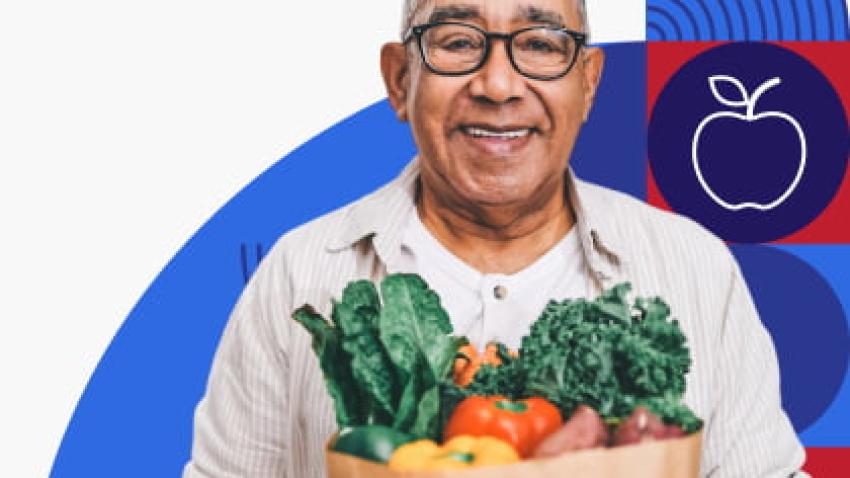Healthy Living
Get Enough Calcium

The Basics
Overview
Calcium is important at every age, but many people don’t get enough. Your body needs calcium to build strong bones when you’re young and to keep your bones strong as you get older. Getting enough calcium is especially important for children and teens, young adults, and women after menopause.
How much calcium do I need every day?
Women:
- If you're age 19 to 50 years, get 1,000 mg (milligrams) of calcium every day
- If you're 51 years or older, get 1,200 mg of calcium every day
Men:
- If you're age 19 to 70 years, get 1,000 mg of calcium every day
- If you're 71 years or older, get 1,200 mg of calcium every day
Kids:
- Babies ages 6 to 12 months need 260 mg of calcium every day
- Kids ages 1 to 3 years need 700 mg of calcium every day
- Kids ages 4 to 8 years need 1,000 mg of calcium every day
- Kids ages 9 to 18 years need 1,300 mg of calcium every day
Check the Nutrition Facts label to find out how much calcium is in your food.
Calcium can help prevent osteoporosis (weak bones).
Osteoporosis is a disease that makes your bones weak and more likely to break. Some people don’t know they have it until they break a bone.
Four in 20 women and 1 in 20 men older than 65 years in the United States have osteoporosis. Calcium helps keep your bones strong and makes them less likely to break.
Foods and Supplements
How can I get enough calcium?
The best way to get enough calcium is to eat foods with calcium every day.
Calcium is in foods like:
- Fat-free or low-fat (1%) milk, yogurt, and cheese
- Soy milk or yogurt with added calcium
- Certain vegetables—including soybeans, collard greens, and turnip greens
- Tofu with added calcium
- Orange juice with added calcium
- Breakfast cereal with added calcium
For more ideas, check out this list of foods that are high in calcium.
Getting calcium from foods is best. But if you don’t eat enough foods with calcium, you can talk to your doctor about taking a calcium supplement every day. You can take a multivitamin with calcium or a pill that has only calcium.
Take Action
Calcium Sources
Here are some tips to help you get enough calcium.
Check the label.
The Daily Value (DV) on the Nutrition Facts label tells you the amount of a nutrient (like calcium) that’s in a serving of the food. Foods that have at least 20% DV of calcium are excellent choices. Foods with at least 10% DV of calcium are good, too.
For example:
- A cup of fat-free milk has about 300 mg of calcium, or 23% DV
- A cup of orange juice with added calcium has about 350 mg of calcium, or 27% DV
Learn how to understand and use the Nutrition Facts label.
To find foods high in calcium when you go food shopping, use this calcium shopping list.
If you take a calcium supplement, make it easy to remember.
Use these tips to help you remember:
- Take it at the same time every day — for example, when you brush your teeth before bed
- Leave the pill bottle out where you’ll see it, like on the kitchen counter or by the bathroom sink. Just remember to keep it out of reach of young children.
Vitamin D
Get enough vitamin D.
Vitamin D helps your body absorb (take in) calcium. Your body makes vitamin D when you’re out in the sun. You can also get vitamin D from:
- Fish like salmon, tuna, and trout
- Fat-free or low-fat (1%) milk or soy milk with added vitamin D
- Some breakfast cereals, yogurt, and juices with added vitamin D
- Vitamin D pills
Talk to your doctor before taking vitamin D pills.
Learn more about:
Follow a healthy eating routine.
Along with eating foods high in calcium, it’s important to follow a healthy eating routine. That means eating a variety of vegetables, fruits, whole grains, and proteins. Learn more about healthy eating.
Content last updated August 31, 2023
Reviewer Information
This information on calcium was adapted from materials from the Office of Dietary Supplements and the Office on Women’s Health.
Reviewed by:
Kara Beckman
ORISE Nutrition Policy Fellow
Office of Disease Prevention and Health Promotion
Dennis Anderson-Villaluz, MBA, RD, LDN, FAND
Lieutenant Commander, U.S. Public Health Service
Nutrition Advisor, Division of Prevention Science
Office of Disease Prevention and Health Promotion
Dana DeSilva
ORISE Health Policy Fellow
Office of Disease Prevention and Health Promotion
Janet de Jesus, MS, RD
Nutrition Advisor, Division of Prevention Science
Office of Disease Prevention and Health Promotion


